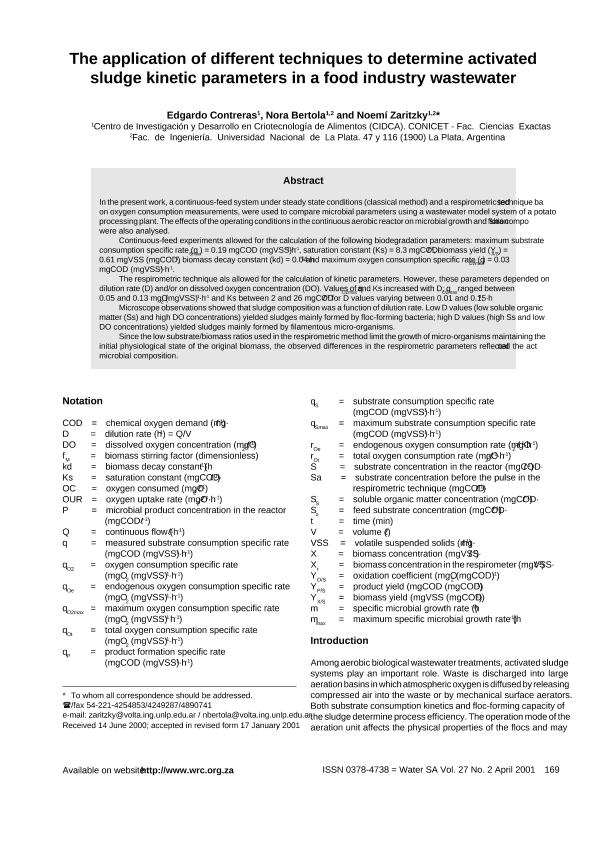Mostrar el registro sencillo del ítem
dc.contributor.author
Contreras, Edgardo Martin

dc.contributor.author
Bertola, Nora Cristina

dc.contributor.author
Zaritzky, Noemi Elisabet

dc.date.available
2020-09-09T16:51:17Z
dc.date.issued
2004-04
dc.identifier.citation
Contreras, Edgardo Martin; Bertola, Nora Cristina; Zaritzky, Noemi Elisabet; The application of different techniques to determine activated sludge kinetic parameters in a food industry wastewater; Water Research Commission; Water S.a.; 27; 2; 4-2004; 169-176
dc.identifier.issn
0378-4738
dc.identifier.uri
http://hdl.handle.net/11336/113635
dc.description.abstract
In the present work, a continuous-feed system under steady state conditions (classical method) and a respirometric technique based on oxygen consumption measurements, were used to compare microbial parameters using a wastewater model system of a potato processing plant. The effects of the operating conditions in the continuous aerobic reactor on microbial growth and flora composition were also analysed. Continuous-feed experiments allowed for the calculation of the following biodegradation parameters: maximum substrate consumption specific rate (qSmax) = 0.19 mgCOD (mgVSS)-1·h-1, saturation constant (Ks) = 8.3 mgCOD·l-1, biomass yield (YX/S) = 0.61 mgVSS (mgCOD)-1, biomass decay constant (kd) = 0.04·h-1 and maximum oxygen consumption specific rate (qO2max) = 0.03 mgCOD (mgVSS)-1·h-1.The respirometric technique also allowed for the calculation of kinetic parameters. However, these parameters depended on dilution rate (D) and / or on dissolved oxygen concentration (DO). Values of qO2max and Ks increased with D; qO2max ranged between 0.05 and 0.13 mgO2 (mgVSS)-1·h-1 and Ks between 2 and 26 mgCOD·ℓ-1 for D values varying between 0.01 and 0.15·h-1. Microscope observations showed that sludge composition was a function of dilution rate. Low D values (low soluble organic matter (Ss) and high DO concentrations) yielded sludges mainly formed by floc-forming bacteria; high D values (high Ss and low DO concentrations) yielded sludges mainly formed by filamentous micro-organisms. Since the low substrate / biomass ratios used in the respirometric method limit the growth of micro-organisms maintaining the initial physiological state of the original biomass, the observed differences in the respirometric parameters reflected the actual microbial composition.
dc.format
application/pdf
dc.language.iso
eng
dc.publisher
Water Research Commission

dc.rights
info:eu-repo/semantics/openAccess
dc.rights.uri
https://creativecommons.org/licenses/by-nc-sa/2.5/ar/
dc.subject
Potato processing plant
dc.subject
Activated sludge kinetic parameters
dc.subject
Respirometric technique
dc.subject
Microscopic obervations
dc.subject.classification
Biotecnología Medioambiental

dc.subject.classification
Biotecnología del Medio Ambiente

dc.subject.classification
INGENIERÍAS Y TECNOLOGÍAS

dc.title
The application of different techniques to determine activated sludge kinetic parameters in a food industry wastewater
dc.type
info:eu-repo/semantics/article
dc.type
info:ar-repo/semantics/artículo
dc.type
info:eu-repo/semantics/publishedVersion
dc.date.updated
2020-09-02T20:22:29Z
dc.identifier.eissn
1816-7950
dc.journal.volume
27
dc.journal.number
2
dc.journal.pagination
169-176
dc.journal.pais
Sudáfrica

dc.journal.ciudad
Petoria
dc.description.fil
Fil: Contreras, Edgardo Martin. Provincia de Buenos Aires. Gobernación. Comisión de Investigaciones Científicas. Centro de Investigación y Desarrollo en Criotecnología de Alimentos. Consejo Nacional de Investigaciones Científicas y Técnicas. Centro Científico Tecnológico Conicet - La Plata. Centro de Investigación y Desarrollo en Criotecnología de Alimentos. Universidad Nacional de La Plata. Facultad de Ciencias Exactas. Centro de Investigación y Desarrollo en Criotecnología de Alimentos; Argentina
dc.description.fil
Fil: Bertola, Nora Cristina. Provincia de Buenos Aires. Gobernación. Comisión de Investigaciones Científicas. Centro de Investigación y Desarrollo en Criotecnología de Alimentos. Consejo Nacional de Investigaciones Científicas y Técnicas. Centro Científico Tecnológico Conicet - La Plata. Centro de Investigación y Desarrollo en Criotecnología de Alimentos. Universidad Nacional de La Plata. Facultad de Ciencias Exactas. Centro de Investigación y Desarrollo en Criotecnología de Alimentos; Argentina. Universidad Nacional de La Plata. Facultad de Ingeniería; Argentina
dc.description.fil
Fil: Zaritzky, Noemi Elisabet. Provincia de Buenos Aires. Gobernación. Comisión de Investigaciones Científicas. Centro de Investigación y Desarrollo en Criotecnología de Alimentos. Consejo Nacional de Investigaciones Científicas y Técnicas. Centro Científico Tecnológico Conicet - La Plata. Centro de Investigación y Desarrollo en Criotecnología de Alimentos. Universidad Nacional de La Plata. Facultad de Ciencias Exactas. Centro de Investigación y Desarrollo en Criotecnología de Alimentos; Argentina. Universidad Nacional de La Plata. Facultad de Ingeniería; Argentina
dc.journal.title
Water S.a.

dc.relation.alternativeid
info:eu-repo/semantics/altIdentifier/doi/http://dx.doi.org/10.4314/wsa.v27i2.4990
dc.relation.alternativeid
info:eu-repo/semantics/altIdentifier/doi/http://dx.doi.org/10.4314/wsa.v27i2.4990
Archivos asociados
